During Panchopachar puja, while waving dhoop (Frankincense) or incense-sticks in front of the Deity, bell is sounded with the left hand. After waving the dhoop, incense-sticks of a specific fragrance are waved in front of the Deity, which attracts the respective Deity’s Principle to a greater extent.
- Deities like fragrant dhoop and hence, they are pleased when dhoop is waved.
- The Raja-predominant waves, which are also associated with Pruthvitattva (Absolute Earth Principle) and Apatattva (Absolute Water Principle) and emitted by dhoop, help in the activation of the waves of inferior Deities in the premises. When these inferior Deities are pleased, they help in restricting the entry of negative energies in the premises.
- Dhoop helps make the environment sattvik (Sattva-predominant).
When a lit incense-stick is waved after showing dhoop, the sagun (Materialised) waves of respective Deities in the universe get attracted to the fragrant particles emitted in its fragrance.
1. While waving dhoop, why should
the smoke not be spread with the hands ?
Vayu (Air) emitted by dhoop is associated with Tejtattva (Absolute Fire Principle) and Vayutattva (Absolute Air Principle). It disintegrates the Raja-Tama particles in the environment through the process of effective flow. Whenever dhoop is burnt in the premises, Raja-Tama particles in the premises gain momentum. The friction caused because of this momentum results in generation of subtle-flames. When dhoop is in an active state, it provides strength to this dynamic energy and brings about disintegration of the Raja-Tama particles in the environment. If the smoke of dhoop is spread with the hands, due to the Raja-Tama vibrations of the jiva’s emotional thoughts, generated either from the hand or emitted through the hand, obstruction is created for the subtle air emitted by dhoop. As a result, the expected function of purification of the premises is not fulfilled by dhoop. Hence, we should not use hands to spread the smoke.
2. Using incense-sticks of various fragrances
according to the tarak or marak form of the Deity of worship
There are two types of Deity worship – tarak (Saviour) worship and marak (Destroyer) worship. Tarak form of the Deity is worshiped to increase bhav (Spiritual emotion) and devotion and to obtain the spiritual experience of Anand (Bliss) and Shanti (Peace) in a short period; for example, by chanting the Deity’s Name in tarak form. Marak form of the Deity is worshiped primarily for overcoming the distress caused by negative energies; for example, chanting the Deity’s Name in marak form. Depending on the worship of the tarak or marak form of a Deity, using substances which can attract maximum taraktattva or maraktattva of the Deity is more beneficial for the worshiper.
| Deity Principle | Fragrance conducive for worshipping the tarak form of the Deity |
| 1. Shri Gaṇapati | Chandan (Sandalwood), Kevada (Screw-pine), Chameli (Jasmine) and Khus (Root of Andropogon muricatus grass) |
| 2. Shriram | Chandan, Kevada, Champa (Magnolia champaca), Chameli, Jai (Common jasmine) and Amber (A kind of aromatic resin) |
| 3. Maruti | Kevada, Chameli and Amber |
| 4. Shiva | Chameli and Heena |
| 5. Durga, Lakshmi and Saraswati | Chandan, Gulab (Rose), Mogara (Arabian jasmine), Kevada, Champa, Chameli, Jai, Khus, Ratrani (Night-blooming Cestrum) and Amber |
| 6. Dattatreya | Chandan, Kevada, Chameli, Jai, Amber and Heena |
| 7. Shrikrushṇa | Chandan, Kevada, Champa, Chameli, Jai, Khus and Amber |
Heena and Darbar are the fragrances conducive for worshiping the marak form of the Deity.
3. How many incense-sticks should be used for worshiping a Deity ?
The number of incense-sticks used varies depending on factors such as spiritual level of the individual, path of spiritual practice, objective of worship, bhav of the individual, tarak-marak form of the Deity etc. One important doctrine of Hindu Dharma is – ‘There are as many temperaments as there are people and corresponding number of paths of spiritual practice’. As per this doctrine, the number of incense-sticks also varies.
In general, a seeker in the initial stage of Shakti-worship should wave five incense-sticks, those who perform puja as part of their duty should wave two incense-sticks and a seeker who performs upasana (Spiritual practice done with the mind) with bhav and devotion should wave one incense-stick. The incense-sticks should be waved thrice in front of the Deity.
4. Incense-stick and the ash obtained after it is burnt
The ash obtained after burning an incense-stick is sattvik and full of Divine characteristics. It is used as Vibhuti (Holy ash) to increase sattvikta and to overcome the distress caused by negative energies. Ash is associated with subtle Pruthvitattva. Due to the fragrance of the ash, it has subtle Vayutattva and is useful for long-lasting effect.

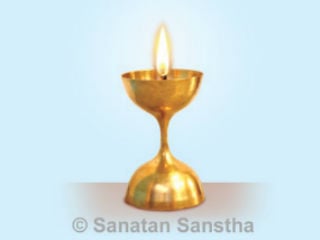 Waving a lit lamp symbolizes puja of Deity with Atmajyoti
Waving a lit lamp symbolizes puja of Deity with Atmajyoti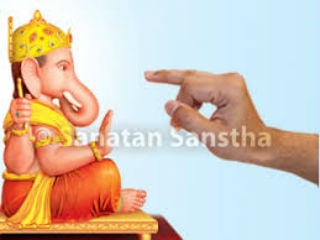 Benefits of applying gandha followed by offering of haldi and kumkum to Deities
Benefits of applying gandha followed by offering of haldi and kumkum to Deities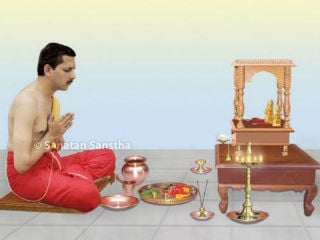 Shodashopachar puja – Means of abiding Dharma in a ritualistic and bhav enriched manner
Shodashopachar puja – Means of abiding Dharma in a ritualistic and bhav enriched manner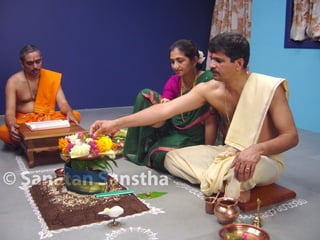 What are the benefits obtained from Puja preparations?
What are the benefits obtained from Puja preparations?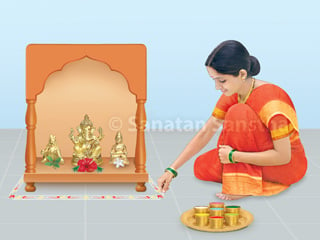 Importance of drawing Rangoli as a part of Puja preparations
Importance of drawing Rangoli as a part of Puja preparations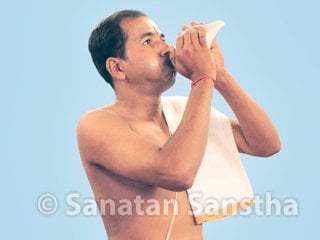 Sounding of a conch at the commencement of a puja
Sounding of a conch at the commencement of a puja
This article shares unique information on lightening the Dhoop sticks in front of the deity at home. Thanks for providing the beneficial post with us.